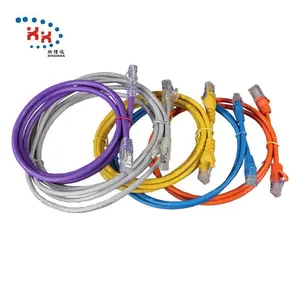Introduction to Ethernet Cable Input
In today's fast-paced digital world, the need for reliable and high-speed internet connectivity cannot be overemphasized. The ethernet cable input serves as a crucial conduit for data transmission, allowing businesses and individuals alike to connect devices to the network efficiently. This product offers a tangible solution to problems stemming from poor connectivity, enabling seamless communication and data sharing. Understanding the various aspects of ethernet cable inputs can empower users to optimize their network setups and ensure uninterrupted access to the internet.
Types of Ethernet Cable Input
Ethernet cables are categorized into several types, each designed for specific applications and performance needs. Here are the most common types:
- Cat5e (Category 5e): Supports speeds up to 1 Gbps over 100 meters, suitable for home networking.
- Cat6 (Category 6): Capable of 10 Gbps speeds over 55 meters, ideal for data-intensive tasks and gaming.
- Cat6a (Category 6a): Extends the range of Cat6 with better shielding for up to 10 Gbps over 100 meters.
- Cat7 (Category 7): Offers advanced shielding and supports 10 Gbps speeds over 100 meters, perfect for data centers.
- Cat8 (Category 8): The latest in ethernet technology, supporting up to 40 Gbps over short distances, optimized for data centers.
Function and Feature of Ethernet Cable Input
The ethernet cable input plays a vital role in network structures, and here are some key functions and features that set it apart:
- Data Transmission: Delivers fast and stable data transfer rates, essential for both residential and commercial networks.
- Built-in Shielding: Many ethernet cables feature shielding to reduce interference from external sources, enhancing performance.
- Durability: Constructed with high-quality materials, these cables are designed to withstand wear and tear for prolonged use.
- Plug-and-Play Design: No need for specialized tools; simply plug in the cable into the ethernet input to establish a connection.
- Backward Compatibility: Current ethernet cables remain compatible with older standards, helping to future-proof your network setup.
Applications of Ethernet Cable Input
The versatility of ethernet cable inputs extends their utility across numerous scenarios. Below are some of the primary applications:
- Home Networking: Ideal for connecting routers, switches, and devices like PCs, game consoles, and smart TVs, creating a stable home network.
- Office Environments: Essential for connecting computers, printers, and IP phones, ensuring smooth business operations.
- Data Centers: High-performance ethernet cables like Cat7 and Cat8 cater to the demanding needs of data centers by allowing rapid data access.
- Educational Institutions: Facilitate network access in classrooms and administrative offices, streamlining communication and resource sharing.
- Public Wi-Fi Hotspots: Providers utilize ethernet inputs to enable users to connect stable internet services in various locations.
Advantages of Using Ethernet Cable Input
The benefits of opting for ethernet cable input over wireless connections are substantial:
- Stable Connection: Ethernet cables deliver a more reliable signal, minimizing dropouts and latency issues common in Wi-Fi networks.
- Higher Speeds: Generally, wired connections boast faster speeds compared to wireless, crucial for gaming or intensive data tasks.
- Enhanced Security: Wired connections are inherently more secure as they cannot be easily intercepted compared to wireless signals.
- Cost-Effective: Investing in ethernet cables can reduce reliance on expensive Wi-Fi equipment and recurring service fees.
- Less Interference: Unlike wireless signals, they are not affected by physical barriers or electronic devices, ensuring consistent performance.









































